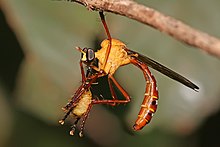Dasypogoninae
Appearance
| Dasypogoninae | |
|---|---|

| |
| Pegesimallus sp. | |

| |
| Blepharepium sonorensis | |
| Scientific classification | |
| Domain: | Eukaryota |
| Kingdom: | Animalia |
| Phylum: | Arthropoda |
| Class: | Insecta |
| Order: | Diptera |
| Family: | Asilidae |
| Subfamily: | Dasypogoninae Macquart, 1838 |
| Tribes | |



Dasypogoninae is a subfamily of robber flies in the family Asilidae. There are more than 60 genera and 520 described species in Dasypogoninae.[1][2][3]
Genera
[edit]These 62 genera belong to the subfamily Dasypogoninae:
- Aczelia Carrera, 1955
- Allopogon Schiner, 1866[4]
- Alvarenga Carrera, 1960
- Amorimius Papavero, 2009
- Annamyia Pritchard, 1941
- Aphamartania Schiner, 1866
- Apolastauroides Artigas and Papavero, 1988
- Apothechyla Hull, 1962
- Araripogon Grimaldi, 1990
- Araucopogon Artigas and Papavero, 1988
- Archilaphria Enderlein, 1914
- Archilestris Loew, 1874 [5]
- Aspidopyga Carrera, 1949
- Aterpogon Hardy, 1930
- Austenmyia Carrera, 1955
- Bamwardaria Hradsky, 1983
- Blepharepium Rondani, 1848
- Brevirostrum Londt, 1980
- Caroncoma Londt, 1980
- Chryseutria Hardy, 1928
- Chylophaga Hull, 1962
- Cleptomyia Carrera, 1949
- Comantella Curran, 1923[6]
- Cyrtophrys Loew, 1851
- Dakinomyia Hardy, 1934
- Daptolestes Hull, 1962
- Dasypogon Meigen, 1803
- Deromyia Philippi, 1865
- Diogmites Loew, 1866 (hanging-thieves)
- Erythropogon White, 1914
- Hodophylax James, 1933
- Lastaurina Curran, 1935
- Lastaurus Loew, 1851
- Lestomyia Williston, 1884
- Megapoda Macquart, 1834
- Metalaphria Ricardo, 1912
- Molobratia Hull, 1958
- Neocyrtopogon Ricardo, 1912
- Neoderomyia Artigas, 1971
- Neodiogmites Carrera, 1949
- Neosaropogon Ricardo, 1912
- Omninablautus Pritchard, 1935
- Opseostlengis White, 1914
- Palaeomolobra Hull, 1962
- Paraphamartania Engel, 1930
- Parataracticus Cole, 1924
- Paraterpogon Hull, 1962
- Pegesimallus Loew, 1858
- Phonicocleptes Lynch Arribálzaga, 1881
- Pronomopsis Hermann, 1912
- Pseudorus Walker, 1851
- Questopogon Dakin and Fordham, 1922
- Rachiopogon Ricardo, 1912
- Saropogon Loew, 1847
- Senobasis Macquart, 1838
- Stizochymus Hull, 1962
- Taracticus Loew, 1872
- Thereutria Loew, 1851
- Theromyia Williston, 1891
- Theurgus Richter, 1966
- Tocantinia Carrera, 1955
- †Stenocinclis Scudder, 1878
References
[edit]- ^ Dikow, Torsten (2019). "Asiloid Flies, deciphering their diversity and evolutionary history". National Museum of Natural History of the Smithsonian Institution. Retrieved 2019-06-03.
- ^ "Dasypogoninae subfamily Information". BugGuide.net. Retrieved 2019-06-03.
- ^ "Dasypogoninae Report". Integrated Taxonomic Information System. Retrieved 2019-06-03.
- ^ Schiner, I.R. (1866). "Die Wiedemann'schen Asiliden, interpretirt und in die seither errichteten neuen Gattungen eingereiht". Verh. Zool. Bot. Ges. Wien. 16 (Abhandl): 649–722.
- ^ Estrada, Alejandro (30 November 2022). "A New Species of the Genus Archilestris Loew, 1874 from Peru (Diptera: Asilidae: Dasypogoninae)". Proceedings of the Entomological Society of Washington. 124 (2). doi:10.4289/0013-8797.124.2.245.
- ^ Dennis, D. Steve; Lavigne, Robert J. (1976-07-01). "DESCRIPTIONS AND NOTES ON THE PUPAE AND PUPAL CASES OF TEN SPECIES OF WYOMING ROBBER FLIES (DIPTERA: ASILIDAE) Reprinted from PROCEEDINGS OF THE ENTOMOLOGICAL S". Proceedings of the Entomological Society of Washington. 78. Entomological Society of Washington: 277–303. ISSN 0013-8797. Retrieved 2024-05-16.
Further reading
[edit]- Dikow, T. (2009). "Phylogeny of Asilidae inferred from morphological characters of imagines (Insecta, Diptera, Brachycera, Asiloidea)". Bulletin of the American Museum of Natural History (319). hdl:2246/5949. ISSN 0003-0090.
- Geller-Grimm, Fritz (2004). "A world catalogue of the genera of the family Asilidae (Diptera)". Studia Dipterologica. 10.
- Hull, F. M. (1962). "Robber flies of the world". Bulletin of the United States National Museum. 224. doi:10.5479/si.03629236.224. hdl:10088/10126.
- McAlpine, J. F.; Petersen, B. V.; Shewell, G. E.; Teskey, H. J.; Vockeroth, J. R.; Wood, D. M., eds. (1981). Manual of Nearctic Diptera, Volume I. Agriculture Canada, Research Branch. ISBN 978-0-660-10731-8.

